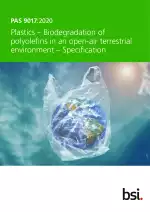PAS 9017:2020 PDF Download
Standard EN SamplePAS 9017 Plastics. Biodegradation of polyolefins in an open-air terrestrial environment. Specification
Also Known As:
What is PAS 9017:2020 about?
Plastic pollution and littering is a huge problem globally, for which to date biodegradability has not been a viable solution. However, that’s now partly changed with the development of innovations that allow polyolefins to degrade in the open air on land. To quickly disseminate such additive technologies across the plastic packaging value chain, a coalition that included industry, government and academic experts has drafted PAS 9017:2020.
This document specifies the requirements of polyolefinic materials enhanced with technology that imparts biodegradability in an open-air terrestrial environment. It also specifies the chemical analysis and the numerical limits required to meet compliance with the PAS at the end of each stage of testing.
Who is PAS 9017:2020 for?
- Plastic or plastic technology manufacturers looking to obtain data as to the performance of the biodegradability of an additive technology within a polyolefinic material in an open-air terrestrial environment;
- Test houses looking to test conformance to the PAS (though note that certification is out of scope and a PAS cannot require the use of independent third-party certification for claims of conformance);
- Standards agencies, national laboratories or academic research groups which could use the test method described in the PAS as a universal baseline methodology for evaluating the biodegradability of new material discoveries within plastics and polymer production
Why should you use PAS 9017:2020?
This PAS specifies requirements for the biodegradability of polyolefins in an open-air terrestrial environment. It covers:
- Polyolefin composition targeted at biodegradability
- Degradation towards biodegradability from weathering, including:
- Criteria for the level of chemical transformation to be achieved by weathering in a simulated open-air terrestrial environment and appropriate test methods
- Method of chemical analysis to be used to yield quantifiable measurement of chemical transformation
- Biodegradation, including criteria for the level of biodegradation to be achieved and appropriate test methods
- An assessment of terrestrial eco-toxicity from weathering
- Claims of biodegradability by manufacturers of end-products or by brands using polyolefin-based packaging for industry and end-markets that the additive based end-products conform with the criteria within this PAS
The PAS does not cover:
- Freshwater, marine, landfill and anaerobic environments of biodegradation
- The effect of marine pollution, such as bioaccumulation of plastics and its effect on biodiversity
- Pre-testing to determine at what point biodegradation is triggered
- A larger concept for the end of life scenarios for plastics and potential recycling pathways
- Assessment of origin of used polyolefinic material and therefore potential resulting biodegradability
- Industrial composting, home-composting or related end of life scenarios for polyolefin-based products
- Compatibility of biodegradable additive-based polyolefin end-products with recycling
- The life-cycle assessment analysis of the end-product, its manufacture, its conversion to packaging and end of life scenarios including littering or leakage from waste management streams
- Claims made by brands or manufacturers to end consumers about polyolefinic end products
NOTE: Claims related to the end products by brands or manufacturers should be made according to ISO 14021.
| Descriptors | Biodegradability, Plastics, Plastics and rubber technology, Plastic packaging materials, Soil testing |
| ICS Codes | 83.080.01 - Plastics in general |
| Language(s) | English |
| ISBN | 978 0 539 13097 3 |
| File Size | 8.0 MB |


